
High Plains Gardening
The gardening website of the Texas High Plains Region
“And after summer evermore succeeds
Barren winter, with his wrathful nipping cold. . . .”
Wm. Shakespeare
Winter is a barren season, frequently bereft of even a single flower. When planning a garden, many gardeners design for spring and summer. Fall, though often neglected, shines the brightest and winter is just plain ignored. It is odd that less attention is paid to how it looks in the off season, winter being the one season gardeners can enjoy the garden without being absorbed in its maintenance.
Although the elements that make up a well designed winter garden are not different than the elements that make up the garden during the growing season, in the Texas Panhandle, gardeners are at a loss for what to plant (see last year's GardenNotes on De-Mystifying Winter Interest). Take a look out your window and analyze your landscape. Does it have interest in winter; does it interest you?
The winter issues of most gardening magazines usually address this subject. There are a number of books, very beautiful books, that highlight the season we should call the “gardeners vacation”, winter. These are usually written by gardeners who garden in the Northeast and Southeast. The photographs are spellbinding, usually well manicured landscapes that gradually fade into the forest, with a gentle layer of snow graciously obscuring anything unpleasant. I have such a book in front of me, The Garden in Winter, Plant for Beauty and Interest in the Quiet Season, by award winning author Suzy Bales. It's been delightful reading her poetic text and dreamy viewing the idyllic pictures that punctuate the text. If only we have a few acres surrounded by forest, 40+ inches of annual moisture and slightly acid soil, we could carve out little winter wonderlands too.
The vista most of our landscapes fade into is the lot next door. Should we live outside the city, our garden would fade into the windy, treeless plains. So, where to begin to develop a garden that invokes excitement in winter?
Magazine articles and books actually do contain many useful ideas we, too, could implement. Much of winter interest is represented by the bones of the garden, the garden hardscape. Increase the visual effect by layering plantings, creating drama by balancing contrast with harmony of shapes, texture as well as color. Unity and rhythm is achieved through repetition. One focal point plant is nice, when placed in a five to seven part composition, genuine interest is created. In small spaces, design pocket vignettes by choosing plants with two or more features of interest, whether it be evergreen and berries, bark or branch color with shape, or shape and winter flowering.
Garden ornaments, colorful pots, pieces of sculpture, even a well placed garden bench offers elements to play off. Anything that will look good in winter, will enhance the garden the rest of the year, and vice versa.
I think the part we get hung up in creating winter interest is on the plant selection. As most books and articles are written from the viewpoint of more garden-friendly climates, our take-away becomes all the plants that won't grow here. No red-twig dogwoods, or the elegant form of Japanese maples, no peeling river birch bark or paperbark maples, no witch hazels, no camellias, no half acre for the shrub border where seven different evergreen leaf colors from green to olive, to golden or conifers tinged with red intermingle. But enough with what we can't have. Let's focus on what we can garden with.
There are a couple of categories that supply interest in winter, as well as interest throughout the year. The winter garden exposes incomplete designs and plant selection idiosyncrasies without deciduous foliage to hide the flaws. Plants for winter (and other seasonal interest) engage the eye and bridge the gap between soil and sky: groundcovers, evergreen and deciduous shrubs, vines and trees. The characteristics we should be looking for in a portion of our plants is what they do in winter. We all have plenty of plants that disappear during the cold dark months, brighten the garden in spring, sustain it through the hot summer and burst forth in one long last hurrah in autumn.
There is an abundant number of plants that brave the winter, some changing colors, others showing their form without their leaf covering. We may not be able to grow plants that thrive in moist acid soils, but we have a good number that prefer life on the dry side in alkaline soils, especially if we improve soil drainage. Expect to expend a lot of thought and searching for specimens of unusual interest to enliven the garden during its period of quiesence, whether one adds a few to borders or beds composed of plants that shine in the dark months of winter.
I'll highlight a few of the many available plants suited to our biome in these standard categories.
Evergreen Groundcovers – non-grass plants that stay low to the ground with a spreading nature.
Periwinkle, Vinca minor, simple elliptic evergreen leaves in a pleasing shade of deep glossy green grows 2-6 inches high with periwinkle blue flowers in March – April. Needs average to low moisture in sun or shade.
Dragon's Blood sedum, Sedum spurium 'Dragon's Blood', and Sedum spurium 'Red Carpet' (photo left). Small succulent foliage, Dragon's blood turns red in cold weather, and 'Red Carpet''s succulent leaves are rimmed with red late spring until cool weather when they turn a deep scarlet. Both are great looking hanging over rocks in rock gardens.
Woolly creeping speedwell, Veronica pectinata (photo right). Gray green leaves all year long can spread to a 20” circle within 3 years. Tiny sky blue flowers can dot V. pectinata any month of the year. Late April - May will find this groundcover smothered in blue. Heat and drought resistant and loves the sun.
Evergreen shrubs – conifers and hollies provide year long interest with colorful evergreen foliage and berries. Conifers are defined as cone bearing shrubs with foliage that is needle-like in pines, flat 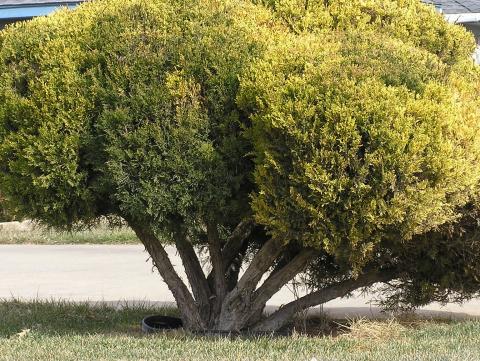 ike yews or scale-like as in arborvitae. Dwarf and miniature conifers have become quite the thing in some circles, making it's way back into fashion. Options
ike yews or scale-like as in arborvitae. Dwarf and miniature conifers have become quite the thing in some circles, making it's way back into fashion. Options abound, even for our challenged climate. There's a wide range of junipers from tall pencil uprights, to broad 10 footers, to lower growing creepers. Juniperus scopulorum ‘Woodward’, a new Plant Select® plants for 2015, the tall pencil juniper that grows to 20' down to Juniperus squamata 'Blue Star', a compact blue needled juniper that hugs the earth to 5-6 inches tall and 8 inches wide. Incorporating one or several conifers of different colors, textures, heights and shape in borders or as foundation plantings provides year long backdrop for flowers placed in front.
Another excellent choice for four season interest is Creeping Oregon Grape Holly, Mahonia repens. Native to the Rocky Mountains, its holly like leaves turn a pleasing red to mahogany in winter. Yellow blossoms highlight this holly in spring, followed by edible blue berries. It's slow to grow for the first few years. Within five years Creeping Oregon Grape Holly can spread nicely to create a woodland scene in shady borders. The taller Oregon Grape Holly, Mahonia aquifolia, grows to 8-10' tall and 6' wide at maturity. (See other SW Evergreens for more suggestions.)
A little used western native shrub is manzanita. There are several varieties in the plant trade, most grows from 1 to 2 feet tall and spreads from 30” to six feet, depending on the variety. Most have evergreen oval or urn shaped leaves, reddish stems and pinkish white flowers in March. Manzanita is native to most SW high desert areas and can be viewed most readily around the Sedona, AZ area. I've grown one of the Plant Select® plants, Panchito manzanita, Arctostaphylos x coloradensis, in a medium moist shade for two full years. However, they are found in sun and part shade dry locations, and require well drained soils.
The unexpected red leaf in winter among the deep green leaves of William Penn barberry, Berberis x gladwynensis 'William Penn', is a welcome sight as a low
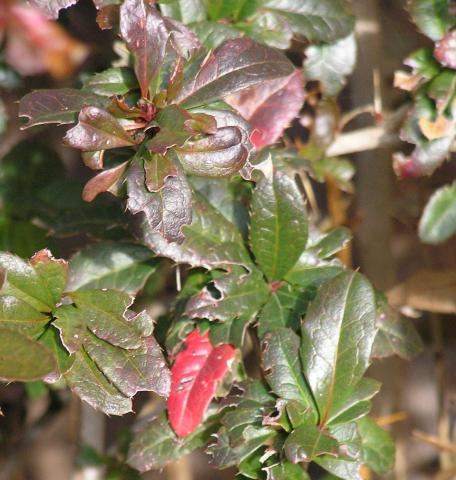 border shrub. Nellie Stevens Holly, Ilex x Nellie R. Stevens, is a reliable holly that can be shaped to a standard, as a hedge or a single specimen. Growing to 20', in the Texas Panhandle, expect smaller mature, trouble free growth around 12'.
border shrub. Nellie Stevens Holly, Ilex x Nellie R. Stevens, is a reliable holly that can be shaped to a standard, as a hedge or a single specimen. Growing to 20', in the Texas Panhandle, expect smaller mature, trouble free growth around 12'.
Boxwoods are highly popular evergreen shrubs and are found in many Amarillo landscapes. Box comes in many sizes and varieties and shades of green. Most require a shady location protected from the wind and evenly moist conditions, especially to prevent leaf burn (leaf dessication).
Rosemary is an evergreen sub-shrub that is subject to bloom in any month. Likewise, scoff not the many thymes that remain evergreen through cold months.
Southwest evergreens – cold hardy agave, cacti, yuccas and other similar plants with evergreen succulent leaves. The shortgrass prairie biome is in a precarious position, lying betwixt and between moister and dryer regions. One cannot feel wholly comfortable gardening only with plants suitable to Southwest regions, or with plants more suitable to moister regions. Our positioning on the map has not given us the luxury of gardening only one way or the other. But we can selectively do both. There are at least six agave species, twenty different yucca species and over two dozen cacti species, not counting their many varieties, that are cold hardy to the Texas Panhandle. Of these three major genera, yuccas add the most variety in leaf color, size, texture and shape to the landscape. Some form trunk-less clumps, others can rise to 12 feet or more at maturity on a multi-branched trunk.
Standards – multi-branched shrubs trained to grow from one main trunk. We are most familiar with roses done as standards, but a few conifers and hollies take to such unusual treatment. If one can find or train them, they make a grand focal point in every season. (Grafted mugo pine in photo to the right, lower left corner.)
Weepers – defying the typical practice of soaring upward and out, trees and shrubs that weep, that is, whose branches hang downward, succumbing to gravity make welcome focal points. Whether evergreen or deciduous, weeping varieties add an element of striking interest in winter. For a large space, the weeping blue Atlas cedar, Cedrus atlantica 'Glauca Pendula' or Tolleson's blue weeping juniper, Juniperus scopulorum 'Tolleson's Blue Weeping' growing to 15-20' tall are hard to beat. Cherry trees have offered fertile ground for developing weepers, as well as redbuds. At the Amarillo Botanical Gardens, look for the weeping redbud, Cercis canadensis var. texensis 'Traveller' (upper right in photo), in the Japanese Garden. Another weeping specimen for small spaces is Lavender Twist® redbud, Cercis canadensis 'Covey', growing to 6-8'T x 8-10'W.
Contorted trees and vines– trees and perennial vines whose shape appears twisted and contorted either naturally or by design. Trunks of trees can be trained when young and supple to twist and twine up poles (which are later removed) or up the posts of pergolas and other free standing structures. Devoid of leaves, their shapes are appreciated during the bleak and barren winter months. In particular, Harry Lauder's walking stick, Corylus avellana 'Contorta', a small deciduous shrub also known as the European hazelnut, grows to 8-10 feet of a highly twisted and contorted nature. As an added bonus to its convoluted form, it sports 2-3” yellowish brown catkins in winter. A specimen can be found in the Randall County Master Gardeners Edible Landscape at Amarillo Botanical Gardens. This curious shrub requires ample moisture and good drainage in sun or part shade.
Berries. Any part of a plant with red color is attractive in winter. Nandinas are my personal favorite, with shiny red berries and evergreen foliage. It is the first week of February, and my nandinas still sport both, although in some years, this is the month they both disappear (leaves return quickly in April). Also still sporting berries is American beautyberry, Callicarpa americana (photo right). A suckering deciduous shrub from 3-6', American beautyberry grows in average garden soil and will grow and fruit (though not as much) in part shade.
Just two more mentions here: gray leaf cotoneaster, Cotoneaster glaucophyllus, which holds its tiny gray leaves and orange berries into winter, and an old standby, firethorn, the pyracantha species. Gray leaf cotoneaster makes a pleasing sun loving low-growing drought tolerant shrub up to about 18 inches by 6 feet. Used quite differently, the firethorn can be dangerous, as its common name indicates. Pyracantha is best trained against a wall in an out of the way location where one can still admire the bright orange berries without bumping into its thorns. There are a number of disease resistant varieties of pyracantha that produce berries in yellow, orange, orange-red and red colors. There's even a near thornless dwarf variety named 'Tiny Tim'. Research whether a female species requires a male for berry production before purchasing berry bearing plants.
Ornamental Grasses – as opposed to turf grass. Ornamental grasses are usually considered bunch grasses, whether warm or cool season, and range from the 6” blue fescues to the 6-8' giant sacaton. A few ornamental grasses are evergreen (usually ever-bluegreen). Ornamental grasses range in blade color in a profusion of of greens, blues, yellows and reds. Sometime after freezing temperatures, many turn shades of tan, but hold their stature and plumes through wind and snow until trimmed back in late winter. They stand tall in the landscape adding structure. One of the best for holding its own through wind and snow is Miscanthus sinensis 'Gracillimus' maiden grass. (For more suggestions, click on one of the Plant Lists.)
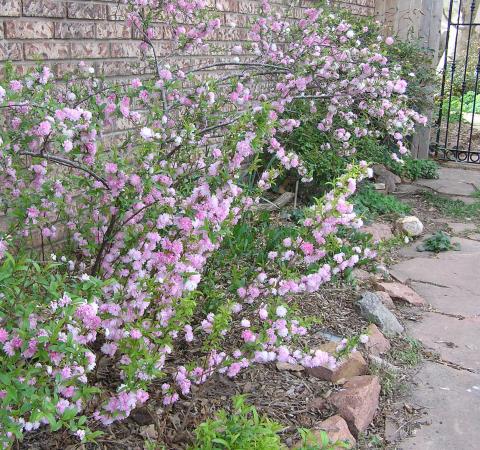
Winter Bloomers and Bulbs – I limit this list of shrubs and bulbs that bloom before mid-March, when exactly, depends on the year. Forsythia is tops on the list for our area, followed by Weigela and flowering quince (Chaenomeles). In truth, most years weigela and flowering quince bloom the later part of March, which to me is spring. However, warm winters could find them blooming early. Closer to the border between winter and spring are the deciduous shrubs pink flowering almond, Prunus glandulosa 'Rosa Plea' (photo right), and golden currant, Ribes aureum. There are many varieties and cultivars of the yellow blooming forsythias, and some truly bloom in February, as well as two weeping varieties, F. suspensa sieboldii and F. suspensa fortunei. Growing to 8', they make a nice green mound in summer. Quite a number of trees bloom in the winter, but their flowers are so tiny and inconspicuous they do not qualify for winter interest.
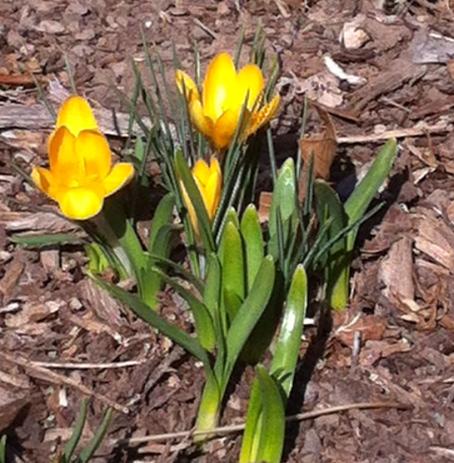 I've already been inspecting the grounds of the first of the very early bloomers: crocus (the early crocus: Crocus chrysanthus, C. vernus, C angustifolius, C. biflorus, C.
I've already been inspecting the grounds of the first of the very early bloomers: crocus (the early crocus: Crocus chrysanthus, C. vernus, C angustifolius, C. biflorus, C. etruscus), daffodils (many early blooming Narcissus species, especially 'Rijnveld's Early Sensation' and 'February Gold'), squill (Scilla bifolia, S. pratensis and S. siberica), snowdrops (Galanthus), snowflakes (Leucojum), winter aconite (Eranthus), and the snow iris (Iris reticulata, I. histriodes, I. danfordiae). Some years, bulbs bloom two to three weeks earlier than usual. This year, the yellow crocus on the left was spotted in full bloom February 9th, a full three weeks earlier than last year on February 27th. My very early daffodils (variety names long since forgotten) planted off a south facing wall sent up their buds yesterday (Feb. 9th), again 2-3 weeks early.
It is a rare sight to see winter aconite in our area. Eranthis hyemalis is the European aconite requiring moist soil, however, similar looking Eranthis cilicica is native to the drier climate of southern Turkey and should do better for us. Some years may find snowdrops (Galanthus) blooming as early as December, in fact, one friend reported this at this Christmas last.
Duc Van Tol tulips, an rare tulip variety dating back to 1595, are the earliest of the tulips to bloom, always in the winter months. A bit pricey at $8.50 a bulb at Old House Gardens, I haven't tried them, yet. All the early blooming bulbs are small and grow low to the ground.
And a final note to our reliable standbys, the pansies and violas. Without the super hybridized versions of the Austrian alpine wildflowers, we would have bare chance of prolonged color in the garden. Pansies and violas give the best value on the dollar, providing eight months of sustained color, October through May. A sunny moist location is all they require to shine through snow. Thought of as annuals, pansies and violas are actually short lived perennials that grow leggy and find it difficult to survive in hot intense summers.
Now is a good time to study ones landscape, either with or without snow, but I think better without the smoothing effect of snow. Pinpoint areas of weakness, as well as strength. Merely noting these facts in ones head isn't lasting. Write them down. If your landscape is relatively blank, start with one bed, border or corner and resolve to design an area with heightened winter interest. Certainly, not every plants needs to be an evergreen. The unchanging nature through the seasons will soon tire the eye. It's those flashes of brilliance throughout the year that bring garden satisfaction.
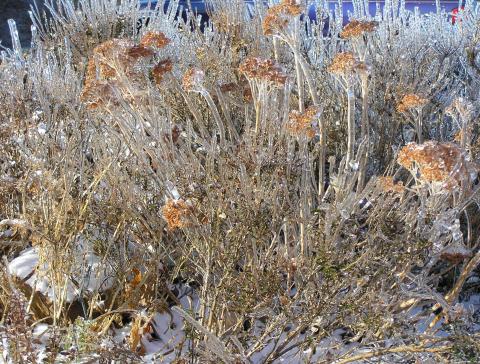 My interest in the winter garden has brought me to pay more attention to the interest my garden engenders in winter. I have vowed a few reforms myself. Although I've added hundreds of bulbs to my garden, this coming fall I will add snowdrops and the winter aconite native to Turkey. This holiday season found me wanting an evergreen holly or conifer for a container; I will look for this as well. I have mahonia galore, seven yucca species/varieties, two agaves and numerous cactus that regard winter with stoicism. Rosemary, thyme, little leaf mountain mahogany, manzanita, periwinkle, woolly creeping speedwell and ornamental grasses combine for the rest of the plants that attract my attention. Lack of thought finds me juniper-less, yea, conifer-less that I will endeavor to rectify. Maybe I'll splurge on a hellebore. And I must have a forsythia. I'm not sure where I will put it, but I know I”ll be looking for one soon, and buying it.
My interest in the winter garden has brought me to pay more attention to the interest my garden engenders in winter. I have vowed a few reforms myself. Although I've added hundreds of bulbs to my garden, this coming fall I will add snowdrops and the winter aconite native to Turkey. This holiday season found me wanting an evergreen holly or conifer for a container; I will look for this as well. I have mahonia galore, seven yucca species/varieties, two agaves and numerous cactus that regard winter with stoicism. Rosemary, thyme, little leaf mountain mahogany, manzanita, periwinkle, woolly creeping speedwell and ornamental grasses combine for the rest of the plants that attract my attention. Lack of thought finds me juniper-less, yea, conifer-less that I will endeavor to rectify. Maybe I'll splurge on a hellebore. And I must have a forsythia. I'm not sure where I will put it, but I know I”ll be looking for one soon, and buying it.
“A gardener must not feel sorry for himself, even in winter, and no matter how great the cause,” (The Essential Earthman, Henry Mitchell on Gardening).
Resources
Angie Hanna, February 10, 2015